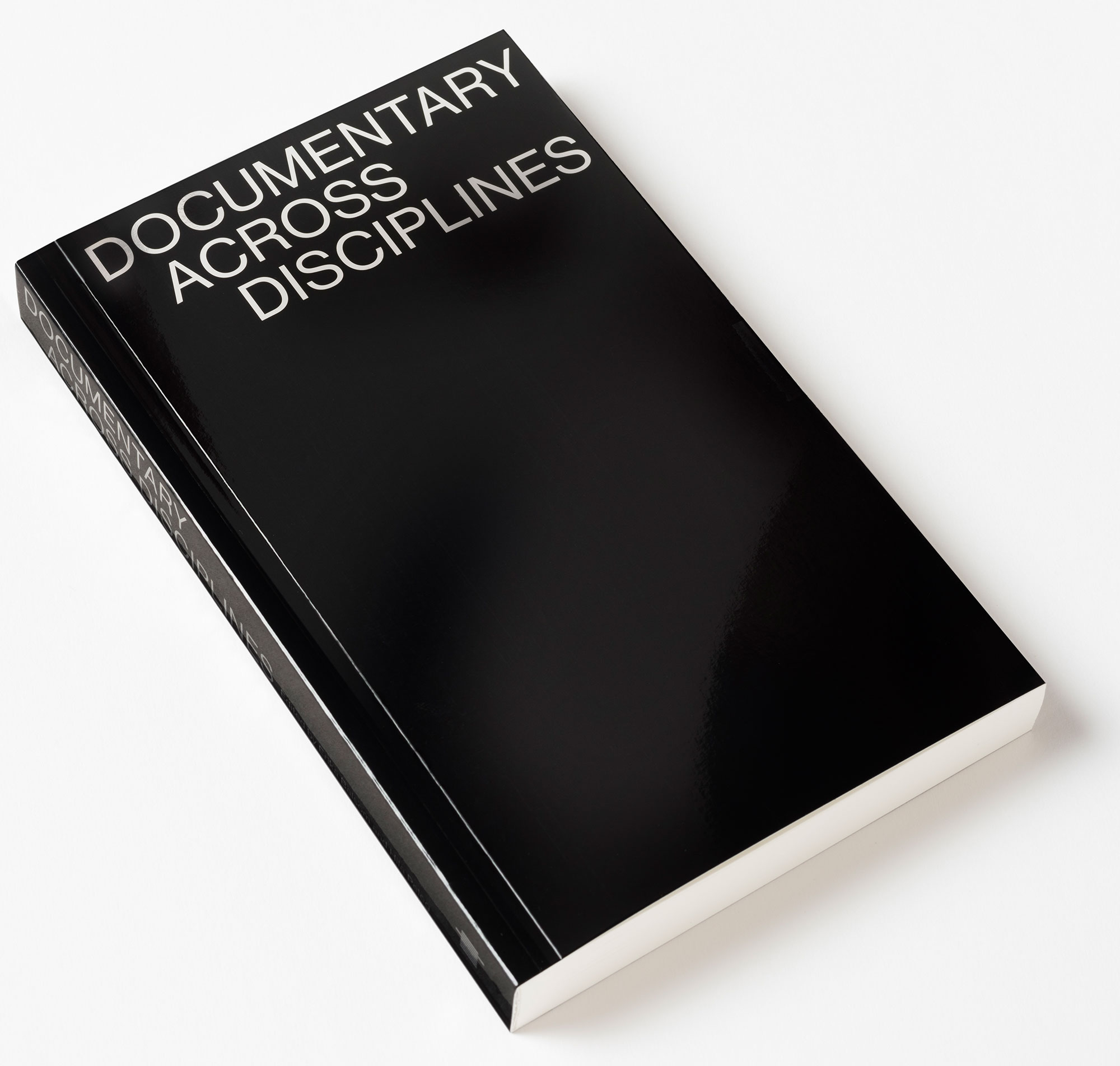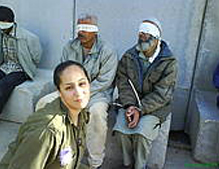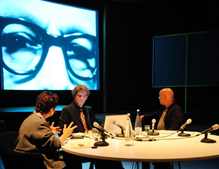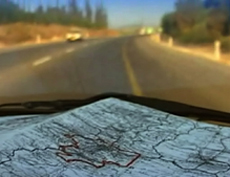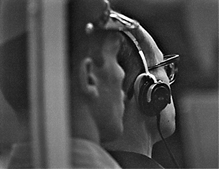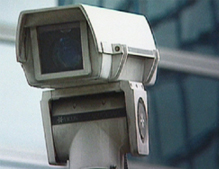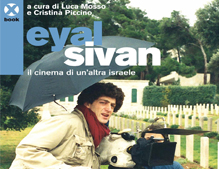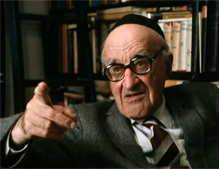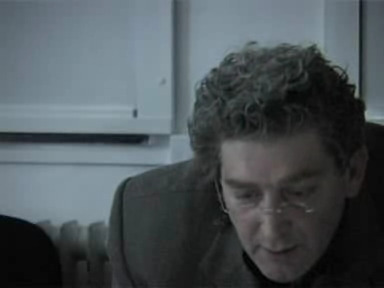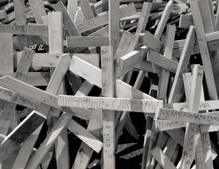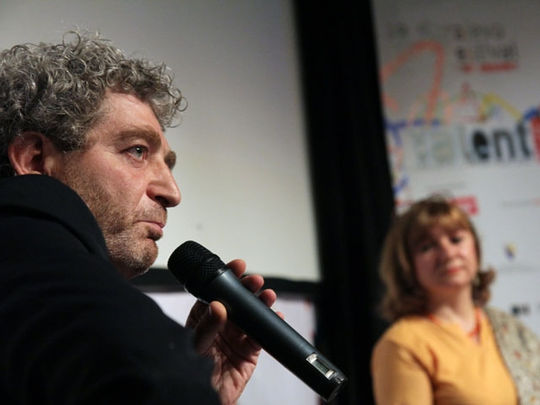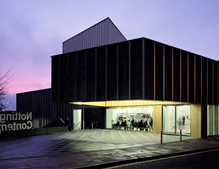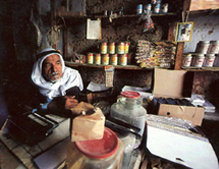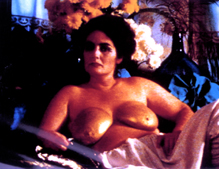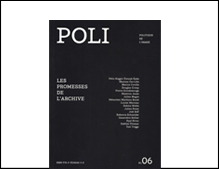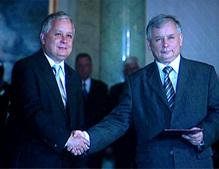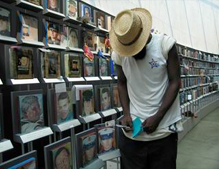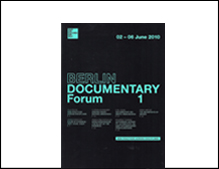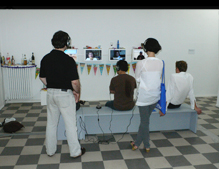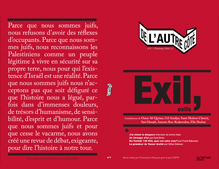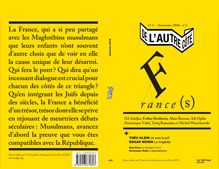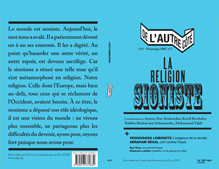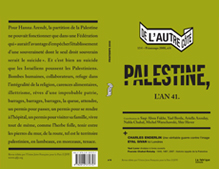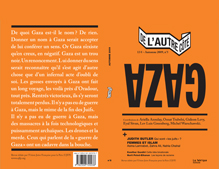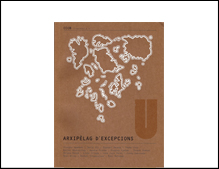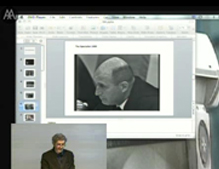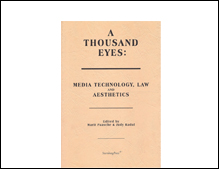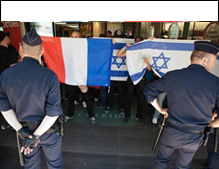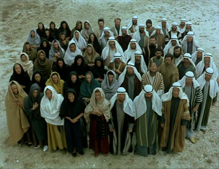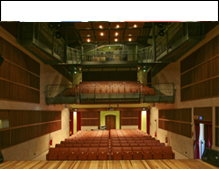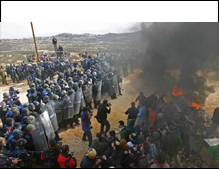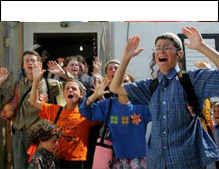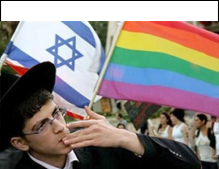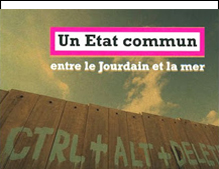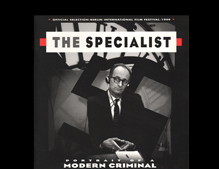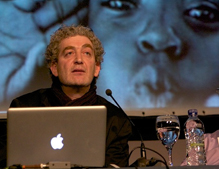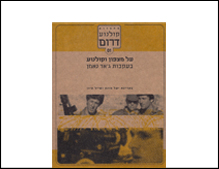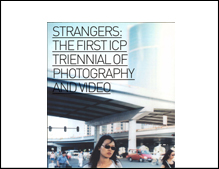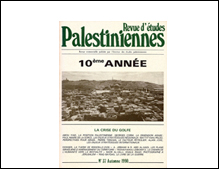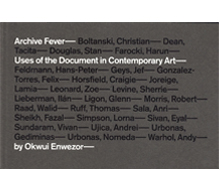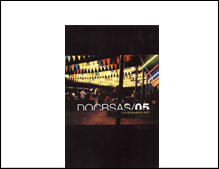-
Proposal for a visual media exhibition
with the participation of students of the Master of Film at the Dutch Film Academy, Amsterdam -
Get my films
Buy DVDs online at www.momento-films.com -
IZKOR
slaves of memory
Documentary film | 1990 | 97 min | color | 16mm | 4:3 | OV Hebrew ST -
Common Archive Palestine 1948
web based cross-reference archive and production platform
www.commonarchives.net/1948 - Project in progress - -
Montage Interdit [forbidden editing]
With professors Ella (Habiba) Shohat and Robert Stam / Berlin Documentary Forum 2 / Haus der Kulturen der Welt / June 2012 -
Route 181
fragments of a journay in Palestine-Israel
Documentary film co-directed with Michel Khleifi | 2003 | 272 min [4.5H] | color | video | 16:9 | OV Arabic, Hebrew ST
-
The Specialist
portrait of a modern criminal
Documentary film | 1999 | co-author Rony Brauman | 128 min | B/W | 4:3 | 35 mm | OV German, Hebrew ST -
Jaffa
the orange's clockwork
Documentary film | 2009 | 88 min | color & B/W | 16:9 | Digital video | OV Arabic, Hebrew, English, French ST
-
Montage Interdit
www.montageinterdit.net
Web-based documentary practice. A production tool, archive and distribution device | project in progress
-
Common State
potential conversation [1]
Documentary film | 2012 | 123 min | color | video | 16:9 split screen | OV Arabic, Hebrew ST -
Towards a common archive
testimonies by Zionist veterans of 1948 war in Palestine
Visual Media exhibition | Zochrot Gallery (Zochrot visual media lab) | Tel-Aviv | October 2012 - January 2013
-
I Love You All
Aus Liebe Zum Volk
Documentary film co-directed with Audrey Maurion | 2004 | 89 minutes | b/w & color | 35mm | OV German, French ST
Increasingly sophisticated technology for recording and reproducing sound and images is altering the traditional theatrical and literary element of the courtroom, writes video installation artist Judy Radul. Considering artwork and theory exploring connections between the image, power, and law, Radul asks whether "it is possible to imagine a court, guided by justice and law, taking into account the new 'politics of representation'"?
"In the playhouse, as in the courtroom, an event already completed is re-enacted in a sequence which allows its meaning to be searched out. [...] The courtroom is, or should be, a theatrical space, one which evokes expectations of the uncommon. [...] Theatrical effects are such dominant factors in the physical identification of a courtroom that their absence may raise doubts about whether a court which lacks a properly theatrical aspect is really a court at all."
Milner S. Ball, Caldwell Professor of Constitutional Law, University of Georgia.
Artists over the last 50 years have dealt with the same questions around representation now being considered by the new, increasingly technologized court of law. The growing prevalence of cameras and technology in the courtroom can be critically discussed in relation to developments in theatrical staging, cinematography, and media art forms.
If, as it seems, the court of law has long been theatrical and perhaps even cinematic – while often attempting to suppress or disavow these tendencies as perilous to the truth – what is happening to court performance as it becomes dispersed across various representational technologies?
The court as stage
The courtroom is like any theatre and the trial like any performance. The lawyers learn their lines and practice their performances. Witnesses are given advice about how to play their roles. [...] The prosecutor directs her witnesses to describe an account of a past event; I attempt to throw doubt on that account. [...] I attempt to unravel the carefully prepared performances of the witnesses, to move them from their script. The witness is now improvising. Without a script, frailties of perception and cognition are soon revealed, sources of contamination exposed, and bias or prejudice indicated. The judge relies on these raw ingredients to adjudge the performance; was it genuine, impartial, reliable, credible or exposed as exaggerated, embellished, unreliable and incredible?[1]
We are in an era where even the term "simulacrum" seems inadequate to represent the entanglement of representations, re-enactments, and simulations which culture stages, not only as art and entertainment, but also as science. Although deconstructive philosophies of the recent past have shifted consideration from a search for truth to a search for the types of meanings produced through discourse itself, the court of law still relies, to a significant degree, on performance to establish both the authority of the court and the veracity of testimony. Milner Ball, a professor of constitutional law (and ordained Presbyterian minister) who writes about the court's relation to theatre (including avant-garde theatre), insists on the "truth function" of performance in relation to the nurturing of the unsuspected or unknown in court. For Ball, it is a question of recognizing the specificity of "court theatre" in distinction to other genres of theatre. "The correct objection to show trials, produced for commercial or political reasons, is an objection not to theatre per se, but to the misappropriation of one type of theatre with its own purpose – trials – for some other type with a different, sometimes dishonourable purpose".[2] In his defence of the live trial, Ball suggests that it not only "may communicate non-verbal information and may correlate with the mind's mode of making judgments", but also that "live presentation is perhaps an inducement to creativity in judgment. [...] It is more certainly an active element in the unclear cases. In these it may give more urgent reality to the particular facts which establish distance between a given case and a general rule." He sees this threatened by increasing expunging of the performative, often under the rubric of greater economy and efficiency.[3]
The court as a "post-medium"
The law enacts itself through a medium of reproduction that is the court of law, simultaneously producing not only judgments and jurisprudence, but also cultural narratives and legal subjects. Traditionally, three interlocking components function as the court mechanism.[4] The first is a built environment (courtroom with judges' bench, witness dock, lawyers' tables, jury box, etc.) in a stable location. This environ structures and frames the court performances, including testimony, argument, judgment, and so on. The second would be the performative elements, including the costumes, rituals, affective and argumentative behaviours. The third component, which literally underwrites the other two, is the use of script in the form of jurisprudence, written argument, testimony, and judgment. Increasingly, "technology" has entered as a broad and unruly fourth element in the presentation, recording, and playback functions of the court.
The first three elements of the schema have been addressed variously by historians of architecture, theorists of performance (although there is much more to be said here), and scholars of jurisprudence, including those of a literary, semiotic, or deconstructionist focus. My interest here is in the fourth element. If we imagine the court as a kind of theatre/recorder/translator machine, the panopoly of new controls introduced by video, networking, and computer technologies has created a very different device. Therefore I will restrict myself to the discussion of built environment, performance, speech, and text only insofar as they are impacted by new technologies in the court. Taken together, the architectural, textual, performative, and media codes of the court form a kind of "post-medium" of reproduction. The term was advanced by Rosalind Kraus in 1999;[5] I use it here to indicate an assemblage of techniques and technologies which function together but are irreducible to a "medium" (such as painting) that can be forced by modernist self-critique to carbonize into its "essential" characteristics.
A newspaper article from 2002, about the opening of Vancouver's "Courtroom 20"[6], shows images of a traditional court augmented by technology and divided from the viewing gallery by a wall of lexan. The court was constructed for the trial of the Air India bombing suspects,[7] and represents the premonition of a future in which such a high-security, technologically sophisticated court is needed on a permanent basis. In contemplating this new courtroom, I recognized a field of activity that related to my work with performance and rehearsal, as well as formal connections to questions about media and staging. Like art, the court of law concerns itself with re-presentation – the reconstruction of past events through words, evidentiary artefacts, and increasingly, pre-recorded sound and images. Courtroom 20 attempts to maintain – through the use of traditional décor, such as red carpet and a wood-grain judges' bench – a sense of authority and decorum amidst a new order of technology and information. The official description of the court proudly emphasizes the technological infrastructure of the built environment.
Total costs for the construction of Courtroom 20 are expected to be about $7.2 million including state-of-the-art computer systems, audio/visual equipment and security systems.
Features include:
- a search gate outside the courtroom similar to passenger security screening at airports;
- Lexan glass to separate the body of the court and the public gallery;
- a public gallery with 149 seats and video monitors at three locations to allow unobstructed views for everyone watching the proceedings;
- a judges' bench that can accommodate hearings by the judges of the British Columbia Court of Appeal;
- 23 seats for prosecution and defense counsel in the body of the court, with space for an additional 15 lawyers if required;
- a witness box and jury box that are both wheelchair accessible;
- integrated state-of-the-art technology for use by all courtroom participants allowing trials to proceed more efficiently, thereby reducing court time and costs;
- Internet access in the courtroom so that prosecution and defence counsel can do legal research or contact their offices;
- 28 microphones for all participants, including lawyers, judges, witnesses and interpreters;
- 384 service outlets (for voice, data, audio, and video distribution);
- Two kilometres of data cable;
- 3 - 40" Plasma Display Monitors and 2 - 36" TV monitors displaying proceedings in the courtroom;
- Four voice-activated video cameras making it possible to transmit proceedings to viewing locations outside the courtroom, if required;
- 25 computer monitors to display electronic exhibits to participants;
- Digital recording system with a storage capacity capable of maintaining two years of rapidly retrievable courtroom audio;
- Evidence Presentation Station supporting DVD, CD, VHS, document camera, notebook computer, image printer and touch screen annotation monitor;
- Video conferencing system designed to use fully integrated microphone and speaker system, with the ability to link with courtrooms in other locations.
The description does not explain that Courtroom 20 has been retro-fitted into the basement of modernist Arthur Erikson's court building, where it's "security-first" bunker-like design sits in contradistinction to the open, glass-ceilinged – justice as public practice – features of Erikson's building[8].
In contrast to this technological bunker, the description of the Supreme Court of Canada relies on traditional symbolic signifiers and stresses the luxury and durability of materials such as wood and marble, rather than the efficacy of networked computer media and impermeability of lexan. Rather than the outside world entering through the window of the computer screen, the room features large windows which allow light of day to mark the passing of time; a courtyard filters, but doesn't obliterate, the sounds of the street.
The difference between this older court and the new technological court can be considered not just from the standpoint of legal technicalities, but also from that of developments in the staging and cinematography of the court performance. If we leave aside the interesting questions around court reporting, it might be said that reproductive technologies of the visual kind entered the court through the use of photographic evidence. Richard Mohr details these interferences (first through descriptions and maps, then photographs and video) of another, competing, zone into the "spatial integrity" of the court.[9] Once we start to contemplate the ways in which technology begins to double and triple the levels of representation, we are confronted with a referential opacity. To take the example of video: one can have video images entered as evidence; live video which represents the proceedings relayed to a local or remote audience (for security or practicality); video of the trial for official records; video of the trial for broadcast; and video of the video presented in court as evidence which may appear in any of these secondary recordings. Cornelia Vismann considers one of these instances: the introduction of video (such as surveillance tapes) as evidence. She hypothesizes that video introduced as evidence displaces some of the more literary aspects of the theatre of the court by "pre-tending" to be "documentary". Therefore, "the emergence of video assumes the functional place of the script for the theatre or play of justice. [...] If this conclusion seems far-fetched, one must at least acknowledge that the emergence of videotapes in trials disturbs the classical alliance between stage and court [...]"[10] She suggests that the linguistic and theatrical "play" of the court is turned into "replay" through video.
Perhaps more broad in scope are questions concerning the recording and potential broadcasting of court proceedings on film and video. In a 1957 article in the Journal of Criminal Law[11] An argument engaged with the de facto transformations wrought by representation (the first piece of evidence might be Margritte's 1926 painting Ceci n'est pas une pipe) does not seem to play a significant role in these debates.
Filmmaker Eyal Sivan, writing on the trial of Adolf Eichmann, points out that although the Nuremberg trials were the first to be significantly recorded (some 12 hours), Eichmann's was the first fully videotaped trial. However, the 500 hours of tape held by the Spielberg Archive have remained largely unwatched. The seventy-two hours prepared as a selection by the archive form a sensational and official history. Sivan found the other 400 hours "stored haphazardly [...] in the only place the archive could find that was cool enough for purposes of conservation: an unused washroom". This is representative, he argues, of a tendency to ignore the original recordings in favour of interviewing victims/witnesses and dramatizing the events of the Holocaust. Sivan quotes the original court filmmaker of the trial, Leo Hurwitz, who already recognized this tendency: "I was terribly excited that Eichmann was going to be tried because it had a possibility of exposing why these events happened. [...] I felt sure that people in Israel would be interested in that [...] but it seemed they were not interested in discovering the nature of fascism. They were only interested in dramatizing the terrible events that happened to Jews."[12] Sivan posits that one of the ways that the original footage doesn't conform to the needs of the dominant narrative is that it humanizes Eichmann. These ambiguities of the image point to the necessity to more fully understand what it is we are recording and producing in the recording of trials.
As Sivan points out, the recording of trials of "crimes against humanity" has become synonymous with the juridical act itself. "After the Eichmann case, it became part of the juridical show to film the trials of those who had perpetrated crimes against humanity [...] with the international criminal tribunals for the former Yugoslavia, in The Hague, and for Rwanda, in Arusha. The latter two courts are actually television studios. The trials are fully recorded: most of the images can be seen on the courts' websites." [emphasis added][13] Yet the status, availability, and form of these images is still ambiguous at best. Construction work on the new purpose-built building housing the International Criminal Court in the Hague will continue over the next several years. However, it seems that while a discussion has begun about the values expressed by an exterior architecture, and about security and other practicalities, there has been no suggestion that the court is no longer just a room but also a production studio.[14] My interest as an artist is in re-imagining this space through the intelligence of art and theories of representation, rather than just a received response to "practical" technological necessities that will reproduce a television studio ideology as well as aesthetic.
The ICTY (International Criminal Tribunal for the Former Yugoslavia) court shares many commonalities with the Vancouver Courtroom 20, but has managed to maintain even less traditional grandeur; it looks like the boardroom of a not very creative (and perhaps not very successful) corporation. As the courtroom becomes more full of video cameras, video monitors, television cameras, computer screens, audio playback and recording, internet interfaces, document presentation stations, and glass dividers, it does retain aspects of the theatre, however, now augmented by the video/audio recording studio.
The court produces its mediated performance through four modes: glass, live video, cinematography (in particular the camera frame in relation to the "out of field", or h'ors champ) and camera stasis (and by contrast, the deterritorialization of the court around this stable camera point of view). By considering these elements, I am inferring that a concept of justice requires a concept of the court theatre, and that without a re-conceptualization, a logic of technological efficiency, which produces a politically conservative, if not repressive form, will increasingly dominate. considering still and moving representations of courtroom proceedings, the argument is between "freedom of the press" and the right to a "public" trial versus potential sensationalism and the prejudicial effect of images. In recent deliberations concerning the presence of cameras in the US Supreme Court, we see this argument being replicated: questions centre around the risks to court decorum, distraction caused by cameras, prejudicial coverage, peril for witnesses, and political grandstanding, which are weighed against the public right to knowledge. In my reading, only Judge Diarmuid O'Scannlain of the appeals court in San Francisco expressed the view that media coverage would positively emphasize the process orientation of the courts rather than results.
Glass and live video
The questions of how the "feedback systems" of reflective materials such as glass, mirror, and video media have affected the social, psychological, perceptual, and power relations that spatial organization affects have been addressed in an exemplary manner in the work of American artist Dan Graham over the past thirty years. His early work on technologically mediated intersubjectivities and his later works on spectatorship in the shopping mall, cinema, park, and theatre are instructive in regard to both the videographic and vitriform aspects of the court.
But first, a mention of an image by Ivan Grubanov, an artist from Bosnia. Grubanov attended Milosevic's trial, during the course of which he found himself less absolute in his opinion and more and more "empathetic" with the complexities of the case. He would attend the trial and secretly sketch the proceedings (as cameras are not allowed in court). The photograph above was sent to him by his relatives in Bosnia. Watching television coverage of the trial, they saw him reflected in the glass separating the audience viewing area and the court. Grubanov then began to make small interventions with this relation, wearing different coloured shirts in order to reflect in succession the colours of the Yugosalvian flag. Dan Graham describes the way in which the glass window divides the object from the consumer, intensifying the commodity status of this glassed-off abstraction. Yet this same glass reflects the viewer and superimposes him or her onto/into the scene behind the glass – this dialectic of exclusion and inclusion is what Grubanov's photo illustrates.
Dan Graham has worked extensively in performances, films, video installations, and sculptural environments built from glass and reflective materials. These works are instructive for the court, which makes increasing use of real-time video and glass dividers while actively attempting to eliminate (or disavow) any of the time/space ego displacements that Graham's works initiate. Graham's works with glass need to be understood as a kind of condensation of his earlier works with real-time video. For Graham, glass, mirror, and video function as divider-connectors; they can variously alienate and encourage identification. In Cinema (1981), Graham imagines a cinema with a screen of two-way glass. Instead of enjoying the isolation of the cinema, when the lights are on in the cinema the audience is on display to the passers-by outside. Conversely, when the cinema is dark, the exterior passers-by see the film as rear projection visible to the street, thereby sharing the experience with the audience in the darkened theatre. A similar effect is in operation in any glassed-off "audience" area that surrounds the court. If the audience area is dark, the court will see itself reflected in the glass. If the audience area is lit, the court will see through the glass and be reminded that its constituent is in attendance. Many other works by Graham use combinations of video/glass/mirror to create physically separate but perceptually connected spaces, which again bear a relation to the division of the courtroom into discreet space for the court players and the audience, augmented by other rooms for translation, the press, and technical control.
Graham has extensively explored the relation of real-time video to the social, psychological, and phenomenological aspects of present perception. Birgit Pelzer writes:
The use of mirrors and glass as wall, spatial divider and screen could create a single, double or triple space. [...] What existed before, during and after became spatial. What was behind me faces me; it appears and disappears. Elements in the recent past return as time supplements the image. For Graham, video made it possible to invert the model of the mirror. By recording images of bodies and their movements displaced in time, by doubling surfaces through reflection, his installations crystallized the fact that the position of the subject depends fundamentally upon a field give by another, by a field of fiction. Instantaneous video relay produces a fictionalization of the present. [emphasis added][15]
Graham has reached a conclusion that a court design could incorporate rather than suppress. That glass walls, mirror, or live video – of course this should be no surprise to anyone – are not "neutral" but create a "fictionalization of the present". In seeing yourself, and seeing yourself seeing yourself, the impossibility of an unmediated accessing of self-presence is rendered. Like attempting to remember a past moment, one meets oneself along the pathway of recall where, as Pelzer puts it, "what was behind me faces me". This phrase also describes a witness' relation to past events, a version of the past stands before you, concretized as testimony, a view with which you must seek a continuity in the present moment (you must testify as substantially the same person who witnessed these events). As in Graham's installations, the time delay may cause the subject in the present to experience "inconsistent impressions which you then respond to, you get caught up in a feedback loop. You feel trapped in a state of observation, in which your self-observation is subject to some outside visible control". The court, it would seem, has a difficult relation with the present. To judge the events of the past, and produce justice in the future, the trial should not be contaminated by the present (in the case of Milosevic's four-year trial, the first judge died and had to be replaced, then the defendant himself died). Live video, what Graham calls a "present-time medium", risks inflating the present time of the court. According to Graham, video's "image can be simultaneous with its perception by/of its audience (it can be the image of its audience perceiving). The space/time it presents is continuous, unbroken, and congruent with that of the real time, which is the shared time of its perceivers and their individual and collective real environments."[16] Videographic interventions could, then, configure the increasingly absent public attendance of the trial in powerful ways. Graham's work insists on the political ambiguity of what he calls the "architectural code" and the "video code". They are most often experienced as enforcers of uninterrogated social hierarchies and power relations; but this should not limit our analysis of their possible effects. In 1979, Graham wrote, "Video in architecture will function, semiotically speaking, as window and as mirror simultaneously, but will subvert the effects and functions of both. Windows in architecture mediate separated spatial units and frame a conventional perspective of one unit's relation to the other; mirrors in architecture define, self-reflectively, spatial enclosure and ego enclosure. Architecture defines certain cultural and psychological boundaries; video may intercede to replace or rearrange some of these boundaries."[17]
In the new courtrooms, the glass, behind which sits the audience, the press and attendant camera crews, and the interpreters, is becoming a standard feature. In Eichmann's trial, it was he that was placed in a glass box for security, like a contained object on display. With a glass divider separating the court into two (or more) distinct spheres, what or whom is "behind" the glass depends on your position in this divided space.
Perhaps the court glass also functions to remind the audience that they can only symbolically join the stage action. However, in their isolation they can experience their identity as an audience. The audience protest during a trial in Courtroom 20 was reported in the local paper. This report subtly suggests that the segregation of the audience turns it into an independent group of performers. At issue was the failure to define the murder of a gay man as a "gay-bashing" or "hate crime" by the court. "At one point [...] someone said, 'Everyone stand in memory of Aaron', and spectators in the gallery, including the victim's family, stood up. Someone shouted, 'This is a hate crime', but the person who told them to stand said, 'Silence please', and they continued standing for more than five minutes [...] Judge Humphries did not react to the demonstration."[18] The audience could not literally be said to have been "disturbing" the court. They staged their own ritual of protest in the zone they perceived as their own.
The court cameras, in the case of Courtroom 20 and the ICTY, present to the spectator a framed view of the very events happening live, in front of them, beyond the glass. This is not an extraordinary event. At rock concerts and sporting events, live coverage of the event is often simultaneously projected, enabling the spectators seated far from the action to have a more intimate view. Some of the obvious differences in the court, however, are the relation to truth and representation that the court must take, the trial duration of months or even years, and the quotidian nature of the proceedings. Also, the court cameras are voice activated, thus reinforce the equivalence of speech and action by only showing a single speaking subject stationed at one of the designated microphones. There is already a level of cinematography taking place focusing on the "talking heads". In the case of Courtroom 20, there are only three camera positions (for someone giving testimony, for the judge, and for the defence/prosecution). In keeping with a documentary "talking heads" aesthetic, everything understood as extraneous to the speech-as-action – that is, other listeners, gestural responses or non-responses, and all the evidence of production, such as other cameras – is framed out. In 1992, Vancouver artist Stan Douglas made a video work which critiques this hierarchy of the image specifically in relation to the improvisational form of "free jazz". It could be said that both musical improvisation and courtroom responsiveness rely on concentrated listening.
The work is a double-sided projection. On one side of the hanging screen, a free jazz session is projected, shot "en direct" and edited in the style of 1960s French musical television. On the other side are simultaneously shown the outtakes, or B camera shots – all that isn't seen on the official side. This treatment relates quite specifically to the politics of form in free jazz. As Vancouver curator Scott Watson writes:
The "official" version records the performance in a way that emphasizes the conventional unfolding or development of a piece of music. But by always choosing to focus on the performer who happens to be carrying the melodic line, this technique also fragments the composition as a whole into a series of atomized events. It is a style oriented towards individual performers, suggesting that the audience is always being offered portraits of personalities expressing themselves in solo passages, rather than centring on the relationships between performers – which is exactly what free jazz is about. The unofficial or imaginary version of the session sets out to depict these relationships by giving emphasis to pauses and intervals, players listening or playing subordinate parts." [emphasis added][19]
Court cameras also highlight the individual and neglect relationships between the court players, thereby losing the power of the discursive. This is a risk the International Criminal Court itself must negotiate, that is, the risk of creating a drama that focuses a complex, systemic, sometimes nationalist crime onto one or a few singular individuals.
Camera movement: The moving court, the static camera
Court cinematography uses live cameras that present the court action to the audience gallery through an array of static automated cameras. The cameras' location in the court is "non-subjective". The camera is in mid-space, not identifiable with any of the players, rather than – for instance – a subjective camera representing the view of the court seen from the point of view of the judge or the defendant. Against this pragmatic stasis, I want to consider the "orientation to disorientation", the flux of memory and reiteration that the moving camera can provide.
The court is bound to site. Richard Mohr[20] writes, "Dating back to Ancient Greece, courts have been held in special places. Homer described the 'polished stones in a sacred circle' which defined the place where the elders decided disputes [...] Legal doctrine itself demands the court be fixed in place [...] Major tensions arise, in courthouse architecture and in law between the place of the court and the other places of which the court must take account: the sites of crimes or injuries, places where witnesses are, and places accessible to the public."[21] Not only are the courts themselves fixed in space, but the players in the court drama are assigned a physical location from which they do not move.
The metonyms "bench" and "bar" are used respectively to refer to the judiciary and the lawyers and give to each the name of the aspect of the built environment by which they assume and maintain their position. This alignment of subject position with physical location produces an interesting theatrical rigidity. However, the introduction of technology such as CCD cameras and presentation television monitors breaks up this real time-real place of the court and, paradoxically, reinforces it. Mohr writes about a trial concerning a mine disaster in which, due to the sophistication of the technology, no visit to the scene of the accident was necessary, although this would have been the norm. Thus, paradoxically perhaps, the court "became even more rooted in its traditional, proclaimed place".[22]
As Mohr points out, traditionally the court has been bound to a location; now, the introduction of cameras allows all types of "remote" events – including a remote judge. Under the headline "Technology Speeds Justice", the Utah Daily Herald reported in 2005 that a Utah judge carried out court business from a hotel room in Oklahoma:
Judge John Sandberg didn't wear his robe but admits he "had to make my room look neat". He was 1 200 miles away in a hotel room in Oklahoma – not a courtroom in Davis County. Laptop computers and tiny cameras are saving time and money and improving safety in Utah's court system. With Internet access, Justice Court judges can conduct routine hearings from virtually anywhere at any time. [...] Video proceedings between courtrooms and jails are not new. But those systems are hard-wired, expensive to maintain and not portable. "This is going to be a godsend", said Judge Dan Gibbons, who handles misdemeanours in Holladay, a Salt Lake City suburb. "We'll cut down the transports from jail to my court by 90 per cent. It's good for prisoners because we can get to them sooner. I'm concerned about their rights, too." Viack [software] spokeswoman Cathy Planchard said the product has been used in health care, financial services and by songwriters who hold "jam sessions" with aspiring performers."[23]
While the camera stays static (embedded in a laptop), a "roaming", not to say "rogue" judge is moving from place to place. It is not too hard to extend this modus operandi, currently motivated by budget and efficacy, to a security response – a logic which insists the court is safer, less of a target, if it doesn't even have a place at all. If, like a covert operator, no one knows where it is from day to day. This paranoid projection aside, even in the case of the "roaming" judge the camera is static – attached to the laptop – just as the cameras in the court are static. A static image is intercut with another when triggered by a speaking subject. Somehow, the static camera of the court is in a contradistinction to the mobility or dematerialization of the court. A static frame pretends to a kind of scientific view while the moving camera introduces complexities of animate and embodied point of view into the proceedings. Art and architecture theorist Anthony Vidler sums up the transformation of space as a subjectification of spatial experience through a new history of moving images. "The modernist avant-gardes, with their emphasis on movement and aesthetic synthesthesia, filmic montage, and cubist rotation, produced their own image of an architecture transformed by spatial performance, the body in space acting as a device by which to undermine the canonical virtues of monumentality."[24]
Akira Kurosawa's film Rashomon (1950) became influential enough in its exposition of the subjective nature of events and their retelling to inspire the term "the Rashomon effect". At the Rashomon gate on the outskirts of tenth-century Kyoto, while seeking shelter from torrential rain, a woodcutter relates an event to a priest and a commoner. Within this retelling, four people recount different versions of the story of a man's murder and the rape of his wife. Much of this is given as testimony and is related to an unseen court, in direct address to the camera, so that by extension the viewing audience becomes the court. Each of the characters, the bandit, the wife/rape victim, the dead samurai (through a medium), and the woodcutter retell their version of the story. The use of flashbacks, contrasting light and dark of the forest, and the camera movements create a "play" with subjective perception, each character embellishing their account in their favour.
In a famous scene early in the film, the camera follows the woodcutter through the chiaroscuro of the sun-dappled forest. The camera is a roaming, pivoting abstraction, not a subjective camera identified with one character's position, as in the "frontal address" sequences of the court, where it takes the place of the judge/viewer. The camera follows the "witness" but makes a helix out of his path. The witness is not impartial, he is inferred to be adjusting his story to conceal the fact that he removed the murder weapon, a valuable dagger, from the scene. The deeper he goes into the grove, the more the camera meanders and turns back on itself. We will never be able to retrace his steps to go back to "the beginning". Like the "bar", past which only court participants can pass, the camera exists on a rail or track. But the camera, in zooming, panning, and tracking, renders the rail not a barrier, but an element in the instantiation of the complex path by which the past crosses to the future by way of cinematic memory.
Conclusion
As we see the court supplement its traditionally literary and theatrical form with new technologies, is it possible to imagine a court, guided by justice and law, taking into account, as artists have done, the "politics of representation"?
In considering this, I am guided by the "legal" interests of both Jean-Luc Godard and Gilles Deleuze. Godard imagines and enacts an image that is much more than a picture. He talks about the "rapprochment" of the image. The image brings things/people/planes/surfaces/movements together in a way that lets us perceive and partake of relationships, new and established. Michael Witt examines Godard's complex idea of cinema as montage.[25] Here, some of the potentials of a truly cinematic court in-production of, and through, complex and potentially radical aspects of justice are suggested:
Godard's reading of how Western society has represented and projected the world around it, and of the ensuing interpretative process (of negotiation, agreement, astonishment, or rejection) [...] feeds into a favoured metaphor: the cinema theatre as popular courtroom, films as evidence and the audience as judge and jury. [...] "Cinema is made for spreading things out, for flattening them. I always compare it to justice. It's a file that you open, that's cinema [...] and then you weigh it." [...] "There's a shot before, and another one after. And between the two, there's a physical support. That's cinema. You see a rich person and a poor person and there's a rapprochement. And you say: it's not fair. Justice comes from a rapprochement. And from then weighing it in the scales. The very idea of montage is the scales of justice."[26]
To take up Godard's challenge is to be reminded of the way the apparatus can bring together reflections in the glass, the accused and the victim, the judge and jury, the past and the present. Deleuze, with his emphasis on empiricism, immanence, situations, and creation, values the case-by-case responsiveness of jurisprudence. In a transcription/translation from his video interviews with Claire Parnet, he announces,
To act for liberty, to become a revolutionary, this is to act on the plane of jurisprudence. To call out to justice – justice does not exist, and human rights do not exist. What counts is jurisprudence that is the invention of rights, invention of the law. [...] Had I not done philosophy, I would have done law, but indeed, jurisprudence, not human rights. Because that's life. There are no human rights, there is life, and there are life rights. Only life goes case by case.[27]
From here we can begin to imagine connecting the present-time medium of video with the rapprochement of montage and the case-by-case invention of jurisprudence. How will our invention make sense of the logic of the Iraqi court which tried Saddam Hussein? This court theatre, which put the defendants in a cage-like dock in the centre of the room, the witnesses in a curtained chamber, and the press behind glass, could not carry its logic to the gallows. The theatre-of-action of the gallows stands in contradistinction to the discursive formality of the court. The unofficial document of the death chamber was, predictably, the camera phone, the covert handheld device whose moving eye shakily watched the final moments, matched the sudden fall, and came to rest on the lifeless face of the condemned man.
- [1] Richard Fowler, "A Lawyer Steps Into Room 302", Artspeak Gallery. http://www.artspeak.ca/exhibitions/text_detail.html?text_id=128
- [2] Milner S. Ball, "The Play is The Thing: An Unscientific Reflection on Courts Under the Rubric of Theater", Stanford Law Review, Vol. 28, No. 1, (Nov. 1975), 81-115.
- [3] This logic is found for instance in the description of the greater use of technology to create efficiency, for instance in the case of the linking of judge and defendant by "remote" means, such as video conference.
- [4] In the same way that many different plays can be produced on the same stage, through the shared mechanisms (acting, directing, stage production) of theatre, I am using the idea of the "court" as rather separate from, although related to, the specific laws it enacts.
- [5] Rosalind E. Krauss, "Reinventing the Medium", Critical Inquiry, Vol. 25, No. 2, (Winter 1999), 289-305.
- [6] Images of Courtroom 20
- [7] The Air India bombing occurred in 1985 and took some 18 years to come to, what was ultimately, in terms of the prosecution, an unsuccessful trial. It went on for four years, cost 100 million dollars, and was unable to prosecute the suspects due to lack of evidence.
- [8] Images of the Supreme Court of Canada
- [9] Richard Mohr, "In Between Power and Procedure: Where the Court Meets the Public Sphere", The Journal of Social Change and Critical Inquiry, No. 1 (1999), www.uow.edu.au/arts/joscci/joscci1/mohr.html
- [10] Cornelia Vismann, "Rejouer les Crimes: Theatre vs. Video", Cardozo Studies in Law and Literature, Vol. 13, No. 1 (Spring, 2000), 133, www.jstor.org/
- [11] Amanda Buck, "Shuttered Justice", The News Media and The Law, Vol 30, No. 1 (Winter 2006), www.rcfp.org/news/mag/30-1/bct-shuttere.html
- [12] Eyal Sivan, "Archive Images: Truth or Memory? The Case of Adolf Eichmann's Trial", Experiments with Truth, Documenta 11 Platform 2, 280 (Kassel: Hatje Cantz, 2002).
- [13] Sivan, 286.
- [14] Conversation with Erik van der Veen, Development and Policy Officer, Coalition for the International Criminal Court.

